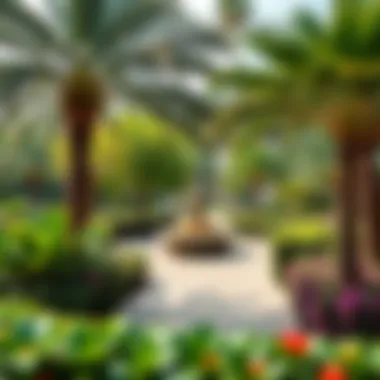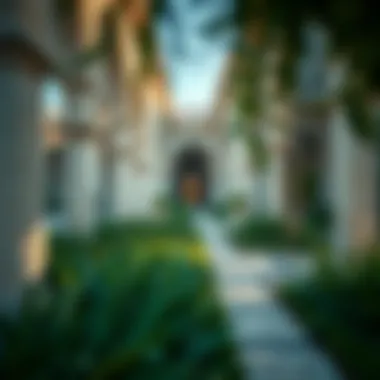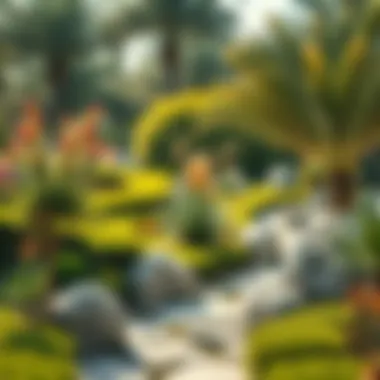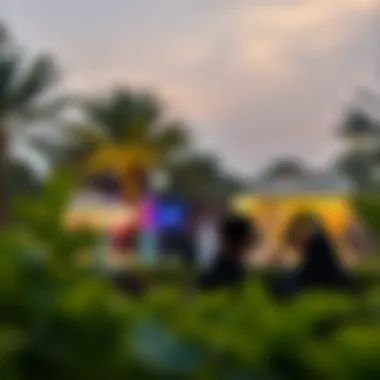مح�مد بن راشد حدائق: Exploring Dubai's Green Oasis


Intro
The Muhammad bin Rashid Gardens stand as a testament to the ambition and foresight of Dubai's urban planners. These gardens not only enhance the city's landscape but also reflect its growing ethos towards sustainability and livability. As we delve into this detailed exploration, we will consider not just the aesthetic and ecological aspects but the profound cultural significance they hold in a city that thrives on innovation and reinvention.
Dubai's rapid development has seen it transform into a global hub, a melting pot of cultures and ideas. Within this vibrant context, the gardens emerge as an oasis, offering residents and visitors alike a chance to connect with nature amid the urban sprawl. Through a careful examination of their design elements, historical context, community involvement, and their role in the real estate market, we will unveil the multifaceted contributions of these gardens to the spatial and social fabric of the emirate.
Ultimately, this analysis aims to arm investors, expats, and property developers with insights into the evolving landscape of Dubai's real estate, particularly in the areas surrounding these gardens. Understanding this dynamic will not only enhance appreciation for their value but also provide an avenue for investment opportunities that capitalize on Dubai’s unique charm.
Prolusion to Muhammad bin Rashid Gardens
The Muhammad bin Rashid Gardens stand as a testament to Dubai's aspirations for creating a harmonious blend of nature and urbanity. Within this urban oasis, the significance stretches beyond its aesthetic appeal; these gardens are seen as vital components to the city's identity, environment, and community. The importance of understanding these gardens lies in recognizing how they serve both ecological purposes and enhance the overall livability of Dubai.
The gardens are designed meticulously, offering more than just a pretty sight. They are spaces where the community can gather, engage in recreational activities, and connect with nature. Given that real estate investors, developers, and property managers are keen on maximizing the utility and value of land, the existence of such green zones directly influences the desirability of adjacent properties.
The Vision Behind the Gardens
The conceptual foundation of Muhammad bin Rashid Gardens originated from a desire to create a sustainable green space in the heart of a rapidly urbanizing city. The vision was not merely to provide greenery but to establish an ecosystem that would enhance biodiversity and serve as a natural habitat. This ambition reflects the principles of modern urban development—where economic growth must go hand in hand with environmental responsibility.
This aligns with Dubai's broader environmental strategies, which have increasingly gained traction. The gardens embody a forward-thinking mentality, seeking to inspire future generations to appreciate the interdependence of urban and natural environments. Public art installations scattered throughout, designed to resonate with local culture, further enrich the gardens by prompting visitors to reflect on the region's heritage.
Geographic and Historical Context
Geographically, the Muhammad bin Rashid Gardens occupy a strategic position within Dubai. Nestled amidst key urban developments, the gardens are easily accessible, which fosters public interest and promotes frequent visitation. Historically, this location was selected to reflect the region's commitment to transforming a desert landscape into a vibrant urban center.
Dubai’s evolution from a modest trading port to a global city has been marked by ambitious projects aimed at enhancing its stature on the international stage. The gardens symbolize this very transformation, serving as a green landmark that juxtaposes the towering skyscrapers surrounding it. Additionally, the integration of local flora into the gardens offers a glimpse into the environmental history of the area. Native plants adapted to the arid climate are pivotal for educating the public about the region's ecology, while also contributing to sustainability efforts.
In summary, the Muhammad bin Rashid Gardens stand out not only for their natural beauty but also for their thoughtful design and cultural relevance. They play a critical role in enhancing Dubai's urban experience, reminding residents and visitors alike of the importance of green spaces in a continuously evolving city.
Architectural Features of the Gardens
The architectural features of Muhammad bin Rashid Gardens greatly contribute to the overall allure of Dubai's urban landscape. These features are not just about aesthetics; they reflect a meticulous design philosophy, embrace sustainability, and establish a strong sense of place within the city. This section explores these captivating aspects in detail.
Design Philosophy
The design philosophy underpinning Muhammad bin Rashid Gardens emphasizes harmony between the natural and the built environment. Every element is crafted to enhance the user experience while preserving local biodiversity. The landscape draws inspiration from traditional Arabic gardens, infusing elements of modernity without overshadowing their historical significance.
This is evident in the choice of materials, where local resources are prioritized to reflect cultural heritage while ensuring durability against the harsh climate. For instance, the pathways composed of natural stone lead visitors through an organic flow, allowing each stroll to feel as if it is enveloped by the very essence of the UAE's landscape.
"The beauty of these gardens lies in their thoughtful design. They tell a story of connection—between man, nature, and history."
Key Structures and Installations
Numerous notable structures within the gardens serve not only functional purposes but also act as focal points for visitors.
- The Reflecting Pool: This body of water is both a functional irrigation feature and an artistic element, mirroring the surrounding flora and architectural structures.
- The Amphitheater: A community gathering space that hosts cultural events and performances, blending leisure with artistry, creating a social hub within the serene setting of the gardens.
- Sculptures and Installations: Thought-provoking artworks scattered across the grounds engage visitors while prompting reflection on environmental conservation and cultural relevance. Each piece is thoughtfully placed to enhance the visual narrative of the gardens.


Integration with Urban Environment
The integration of Muhammad bin Rashid Gardens with the surrounding urban fabric showcases a pioneering approach to landscape architecture. Unlike many green spaces that exist merely as oasis, these gardens work in tandem with the bustling metropolis.
The strategic location makes it accessible to both locals and tourists, fostering a sense of community. Connectivity to public transport and pedestrian-friendly pathways ensure that the gardens are not isolated green patches, but rather integral parts of the city’s layout.
Furthermore, the gardens serve as a crucial ecological buffer. They mitigate urban heat through vegetation, resulting in cooler microclimates. The incorporation of sustainable practices, such as rainwater harvesting and xeriscaping with drought-resistant plants, aligns well with the global movement towards urban sustainability.
Ecological Impact and Sustainability
The ecological impact and sustainability of the Muhammad bin Rashid Gardens are double-edged swords that sharpen the narrative of this urban sanctuary. In a world where urban sprawls pose threats to natural ecosystems, these gardens stand as a symbol of how thoughtful design can harmonize nature with city life. The emphasis on ecological considerations not only enhances biodiversity but also ensures that the gardens are an enduring feature in the ever-evolving landscape of Dubai.
Native Flora and Fauna
A key element of the gardens’ ecological narrative is the commitment to native flora and fauna. Dubai, with its unique desert environment, presents a distinctive opportunity to showcase plant species that thrive in arid conditions. Diligent efforts have been made to integrate species like the Acacia tortilis and the Euphorbia larica, which are not only well-suited to the local climate but also serve as habitat for a variety of fauna. By prioritizing these species, the gardens not only promote biodiversity but also minimize water consumption, which is a crucial consideration in this parched region.
Moreover, these native plants attract local wildlife, fostering a small ecosystem within the gardens. The presence of local birds, such as the Lesser Grey Shrike, adds an auditory tapestry, while butterflies flit about, pollinating as they go. The gardens essentially become a biological refuge, rather than just a visual delight.
Water Management Strategies
In a city where the desert landscape looms large, water management is no trivial matter. Muhammad bin Rashid Gardens employ innovative strategies that underline sustainability in water use. For instance, drip irrigation systems are useful as they provide water directly to the roots of the plants, reducing evaporation and waste. Along with this, the smart use of rainwater harvesting systems captures seasonal rain, further supplementing the garden’s water supply.
The design incorporates retention basins, which not only manage stormwater but also nourish the surrounding plant roots. This dual-purpose approach ensures that even excess water isn't wasted but rather put to beneficial use. Such methods position the gardens as a leading example for future developments in water-scarce areas, echoing a broader message about responsible resource management.
Energy Efficiency Initiatives
Energy efficiency within Muhammad bin Rashid Gardens is another pillar of sustainable practice that cannot be overlooked. The gardens make use of solar energy to power various facilities, significantly reducing their carbon footprint. Solar panels are strategically placed on visitor centers and amenities, offering renewable energy sources while also showcasing how such initiatives can operate in urban settings.
Beyond solar energy, the gardens incorporate energy-efficient lighting solutions, utilizing LED lights that not only save electricity but also create a softer, more inviting nighttime ambiance. Along these lines, sustainable construction practices during the garden's development have included using recycled materials, further driving home the message of environmental responsibility.
“Designing with nature in mind creates spaces that are both beautiful and sustainable, highlighting our commitment to the environment.”
Cultural Significance of the Gardens
The cultural footprint of Muhammad bin Rashid Gardens within Dubai transcends mere aesthetics. These gardens serve as a vibrant hub of community interaction and cultural preservation, providing a canvas for artistic expression and a stage for various social events. Essentially, they forge a connection between the natural world and cultural heritage, underpinning Dubai's identity as a cosmopolitan city woven from diverse cultural threads.
In a rapidly urbanizing landscape, gardens offer a crucial respire from the city’s hustle and bustle, creating spaces where residents and visitors alike can engage with nature. The significance lies not only in their beauty but in their role as a social equalizer. By making these gardens accessible to all, the government fosters inclusivity, ensuring that everyone, regardless of background, can enjoy the beauty and tranquility these spaces provide.
"In the heart of the city, these gardens blossum beyond the mere plants, they are the living memory of our community and its evolving identity."
Cultural Events and Festivals
Throughout the year, Muhammad bin Rashid Gardens become a focal point for various cultural events and festivals. These gatherings are more than just celebrations; they reflect the rich diversity of the city and offer a platform for communal participation. Events like the Dubai Flower Festival draw in crowds, showcasing stunning floral displays while encouraging local flora appreciation.
Typically, the events include activities craft markets, food stalls serving traditional delicacies, and performances from local artists. This blend of entertainment and cultural education fosters a sense of belonging among attendees. People from different walks of life come together, sharing experiences and creating memories under the shade of the lush greenery.


Moreover, specific festivals dedicated to cultural narratives—such as Emirati Heritage Day—serve to educate visitors on the traditions and values of the UAE. They include demonstrations of traditional crafts, folk music, and dance, which allows both residents and tourists to engage and reconnect with the cultural roots.
Community Involvement and Education
The gardens are also a beacon for community involvement and education. Schools often organize field trips to the gardens, where students learn about native plant species, ecosystems, and sustainable practices. These educational endeavors aim to inspire the younger generation about environmental conservation and the importance of green spaces in urban areas.
Local volunteer programs invite residents to participate in maintenance and planting days, thereby fostering a sense of ownership and stewardship over the gardens. This interaction builds community bonds, as individuals work side by side, reinforcing communal ties and promoting a collective responsibility towards preserving the natural environment.
Additionally, workshops frequently occur, focusing on topics like gardening techniques, composting, and biodiversity. These initiatives not only equip community members with practical skills but also contribute to building a knowledgeable and environmentally-conscious populace. Through active participation, the gardens become a living classroom where both adults and children can learn from nature’s lessons while nurturing their connection with the environment.
Visitors’ Experience
The experience of visiting Muhammad bin Rashid Gardens is multifaceted, merging both leisure and education in a space that is not just a park, but a vital part of Dubai's social and ecological fabric. Located strategically within the city, these gardens offer a sensory feast through their rich flora, artistic installations, and engaging recreational areas. Understanding the insights on what visitors can expect lays the foundation for appreciating the gardens' role in enhancing community life and tourism.
Plan Your Visit
When organizing a trip to Muhammad bin Rashid Gardens, a little planning can make a world of difference. Consider the time of year; winter months generally attract more visitors due to milder temperatures, creating an inviting atmosphere for outdoor activities. The gardens are open year-round, but weekends can be a crowded affair. To avoid the hustle and bustle, a weekday visit is often more enjoyable.
- Opening Hours: Typically, the gardens open early in the morning and remain accessible until late evening, allowing various visitors to experience the gardens at different times.
- Entry Fee: Most areas are free to visit, though select attractions might have a nominal fee. Being aware of any costs can help manage your budget for the day.
- Getting There: Easily accessible via public transport or car, the gardens are situated near major roads, making navigation simple for both tourists and locals.
Guided Tours and Accessibility
Opting for a guided tour can enrich the experience profoundly. Knowledgeable guides can provide insightful commentary on the gardens’ history, plant species, and architectural features that one might overlook when exploring alone. These tours often enhance engagement through personal stories and detailed information.
Accessibility is another critical feature that ensures all visitors can enjoy the site. The gardens are designed with various pathways that accommodate strollers and wheelchairs, allowing everyone to roam freely. Features enhancing accessibility include:
- Smooth Walkways: Wide paths and ramps create an easy flow for visitors with mobility challenges.
- Dedicated Parking: Ample parking spaces are available, especially designated for those needing assistance.
- Information Panels: Throughout the gardens, signposts in multiple languages offer details about the flora and fauna, catering to Dubai’s diverse audience.
Activities and Attractions
Engagement is key to the overall visitor experience at Muhammad bin Rashid Gardens. A host of activities beckons visitors to explore and enjoy their time. These include:
- Nature Trails: Wander through nature trails dotted with aromatic plants and vibrant flowers.
- Interactive Installations: Art installations not only beautify the park but also invite interactions, encouraging creativity and imagination.
- Workshops and Classes: Seasonal activities often include gardening workshops, eco-awareness classes, and cultural gatherings that deepen ties within the community.
As gardens are not merely patches of grass but living entities, they adapt with the seasons, ensuring that every visit offers something new.
In summary, the visitor experience at Muhammad bin Rashid Gardens is tailored to entertain, educate, and engage all who enter its gates. Those planning a visit can anticipate a day filled with discovery, relaxation, and cultural richness.
Economic Influence
The economic influence of Muhammad bin Rashid Gardens is multi-faceted, extending far beyond mere aesthetics. These gardens are not just green spaces; they are pivotal in shaping the urban landscape and generating economic activity within Dubai. As real estate and community development merge, this area serves as a model for how parks can act as catalysts for growth, enhancing property values and attracting investment.
Impact on Real Estate Development
The gardens have significantly affected real estate development in their vicinity. Properties adjacent to these lush expanses have witnessed a noticeable uptick in value. The allure of breathing spaces combined with nature's serenity often translates into premium pricing for homes and commercial spaces alike. Investors and developers are keenly aware of this trend.


- Increased Property Values: Real estate experts agree that access to green spaces often leads residents and buyers to place a higher value on properties nearby. The combination of recreational space and aesthetic beauty tends to drive demand.
- Development Incentives: Local authorities have recognized the gardens' economic significance. Incentives for developers to construct residential and commercial properties near the gardens can stimulate further investment. This leads to job creation, thereby enhancing the community’s economic fabric.
- Mixed-Use Developments: The area surrounding the gardens has seen a surge in mixed-use developments. The integration of retail, residential, and recreational spaces is a strategy not only to optimize land use but also to create vibrant hubs of community life. These developments ensure that the gardens remain accessible and well-maintained.
Tourism and Local Business Growth
The gardens additionally bolster tourism and local businesses, contributing to Dubai's reputation as a premier tourist destination. Visitors drawn to the gardens often seek nearby dining and shopping experiences, enriching local commerce.
- Tourist Footfall: The aesthetic value and cultural significance of the Muhammad bin Rashid Gardens attract tourists year-round. This high foot traffic benefits nearby businesses, from quaint cafes to upscale boutiques, allowing them to thrive.
- Economic Synergy: The gardens host various festivals and events that draw in both locals and tourists. Such gatherings generate extra income for surrounding businesses. Local crafts, food stalls, and activities during events not only enrich the visitor experience but also provide a platform for local entrepreneurs.
- Sustainable Tourism: The emphasis on sustainability within the gardens attracts environmentally conscious tourists. This eco-friendly approach encourages businesses to adopt greener practices, appealing to this demographic.
In essence, the interaction between Muhammad bin Rashid Gardens and economic development creates a symbiotic relationship that benefits not just the investors but also the community and visitors alike.
The gardens, therefore, stand as a testament to how green spaces can significantly influence real estate and stimulate local economies, making them essential contributors to Dubai’s vibrant urban landscape. Investors and community members must understand this dynamic to fully leverage the opportunities presented by these green havens.
Future Developments
The future of Muhammad bin Rashid Gardens is not just a matter of landscaping, it is a reflection of Dubai's ambition to integrate nature with urban life. As the city continues to grow, the gardens are poised to play an even more significant role. The importance of discussing future developments lies in understanding how the gardens will adapt to meet the needs of the community while preserving their natural beauty. Here, we explore planned expansions and innovative landscaping techniques, both aimed at enhancing the overall experience and ecological footprint of these gardens.
Expansion Plans
Future expansion plans for the gardens involve integrating new areas that will capture the essence of both historical and modern Dubai. Authorities aim to develop additional green spaces that connect various neighborhoods, ensuring that the gardens are accessible to all. One key component of these expansion plans is the addition of interactive spaces that encourage community engagement. For instance:
- New Play Areas: Expanding zones dedicated to families and children to foster a sense of community bonding.
- Themed Gardens: Each new section may reflect different cultural influences—perhaps a Japanese Zen garden or an Arabian desert garden that highlights native flora.
- Underground Infrastructure: Advanced planning is set to incorporate smart utilities and irrigation below ground, ensuring that the landscape remains lush without impacting the surface aesthetics.
These enhancements will not only serve recreational purposes but also offer an educational avenue, promoting awareness about local ecology and sustainability. Furthermore, as the area increases in size, it will likely open up opportunities for local businesses to thrive, thus intertwining economic growth with environmental stewardship.
Innovations in Landscaping and Design
An exciting aspect of the future developments is the introduction of innovative landscaping and design methods. These innovations are set to redefine the way gardens can contribute to urban life. By using cutting-edge technology and sustainable practices, the gardens will evolve into an ecological haven that melds beauty with efficiency. Key innovations include:
- Smart Irrigation Systems: Utilizing sensors to monitor soil moisture, minimizing waste and ensuring the plants receive optimal water supply.
- Vertical Gardens: As space becomes a premium, vertical planting systems will allow for a striking aesthetic while maximizing greenery in limited spaces.
- Native Plant Species: Emphasizing the use of indigenous flora that requires less maintenance and supports local wildlife, reducing the need for extensive resource consumption.
"A well-designed garden is not just a place for plants but a living testament to ecological harmony".
These innovations do not only beautify the landscape but also bolster the gardens' ecological resilience, making them an essential component of Dubai's sustainable future. The integration of technology and nature will serve as a powerful example of how urban spaces can coexist with the environment amicably.
Closure
The exploration of Muhammad bin Rashid Gardens reveals not just a space for leisure, but an integral part of Dubai's urban fabric. Understanding the importance of this topic fosters a deeper appreciation for what's being cultivated beyond mere greenery. Here, we delve into the crucial elements, benefits, and considerations surrounding the gardens.
Summary of Key Insights
This article outlined several essential aspects that define the Muhammad bin Rashid Gardens. The gardens serve as a hub of cultural engagement, promoting local events that bring the community together. They are strategically placed within Dubai's urban landscape, enhancing the livability of the area while simultaneously acting as green lungs for the city. Furthermore, the gardens embody sustainable practices, ensuring ecological balance through effective water management techniques and native species integration.
The economic implications are significant as well; they boost local businesses and contribute to the real estate market’s growth, drawing in investors and homeowners alike. This multidimensional approach underscores their role as a symbol of progress and innovation in Dubai.
Final Thoughts on the Importance of the Gardens
Muhammad bin Rashid Gardens is more than just a collection of plants and pathways. They reflect a vision for a sustainable and livable environment, offering a sanctuary away from the bustling city life. The melding of architectural beauty and ecological sensibility is crucial for the present and future of urban development in Dubai.
These gardens stand as a testament to the rising significance of green spaces in metropolitan areas. As investors, realtors, expatriates, and property managers strive to navigate the ever-evolving landscape of Dubai, the gardens serve as a reminder of the balance needed between development and sustainability.
"In a world driven by progress, these gardens offer a vision where nature and architecture coalesce into a single, harmonious space."
The future of these gardens is not solely about maintaining aesthetics; it encapsulates a broader commitment to community engagement and ecological preservation. Understanding these dynamics is essential for anyone looking to invest in or experience the evolving identity of Dubai. Engaging with the vision behind Muhammad bin Rashid Gardens opens up myriad possibilities for growth, creativity, and reciprocal enrichment for the city and its citizens.















